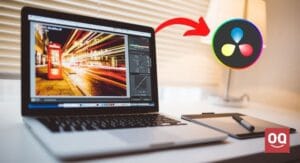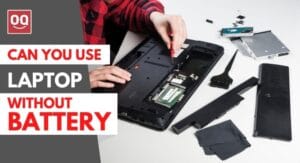Work laptops usually have several programs installed that are specific to the company and that the employee may not need or want on their personal computer. These laptops have also been configured to connect to the company’s network and may have other security measures in place.
But, when a company no longer employs you, or if you find yourself more comfortable and productive when working from home, converting your work laptop into a personal one may be an excellent option to think about. It will give you the convenience of having a laptop that is already set up and ready to go, without all of the work-related software and security restrictions.
However, converting a work laptop to a personal computer is not easy, and there are several challenges that you may face. Therefore in this article, we will explore how to convert work laptop to personal.
So, without further talk, let’s get started.
Note: Before starting the process, it is essential to check with your employer to make sure that you are allowed to take the laptop off of their network and use it for personal purposes.
Assuming that you have permission from your employer, here are a few tips on how to convert your work laptop into a personal computer:
1. Backup your work laptop
Before making any changes to your work laptop, the first and most important thing you need to do is create a backup. This will ensure that all of your work-related files and data are safe and sound.
This is very important because if anything goes wrong during the process of converting your laptop, you will have a backup to fall back on. Also, if your boss asks you to return the laptop, you can quickly restore it to its original state.
Read: Best Laptop for Psychology Students
There are several ways to create a backup of your work laptop. One way is to use an external hard drive. Simply connect the hard drive to your laptop and copy all of the files you want to keep onto it. You can also use cloud storage services available, such as Google Drive, Dropbox, and iCloud.
2. Disconnect from work networks
Once you have backed-up all of your files, the next step is to disconnect from any work networks. This includes any email accounts, VPNs, or other connections your laptop has to the company’s network.
It will ensure that there is no way for your employer to track or remotely access your laptop once it has been converted to a personal computer. Plus, it will also help to protect your privacy.
However, before disconnecting from work networks, it is essential to check with your employer. This is because some companies may have policies in place that state that you are not allowed to disconnect from their network without permission.
3. Uninstall work-related programs
The next step is to uninstall any work-related programs from your laptop. This includes any software that was installed by your employer, such as productivity apps, email clients, and so on. Also, remove any bloatware that came with the computer.
If you are not sure which programs are work-related and which are not, a good rule of thumb is to uninstall any programs you do not use daily.
But make sure you look at each program before uninstalling it, as you may find that some of them are actually useful for personal use. Also, you should take a backup of important files.
4. Disable anti-virus Programs
Work laptops usually contain very strict security measures, including anti-virus software designed to protect the company’s network from being infected by malware. But for personal use, you don’t require such a high level of security.
Therefore, it is recommended that you disable or uninstall any anti-virus software from your work laptop. These programs are not necessary for you. In fact, it can actually be a hindrance, as it may prevent you from installing certain programs or accessing certain websites. The Windows Defender should be enough for you.
5. Perform a factory reset
If you want to remove all traces of your employer from your laptop, then the best way to do it is to perform a factory reset. This will erase all of the files and settings on your laptop and restore it to its original state.
To perform a factory reset, you will need to go into the Settings app and navigate to the Recovery section. From there, you can follow the instructions on how to reset your laptop.
However, before performing a factory reset, make sure that you have backed up all of your essential files because a factory reset will delete everything on your laptop, including your personal files.
6. Reinstall the Windows
Once you have reset your laptop to the factory, reinstall the Windows operating system. This will give you a clean slate to start with and will get rid of any work-related files or settings that may still be on your laptop.
To do this, you will need to insert the Windows installation media into your laptop and follow the instructions on how to install it. Here I am attaching a video for your convenience.
7. Change your settings to personal preferences
After installing the Windows operating system, it is time to change the settings to your personal preferences. This includes things like the wallpaper, screen saver, and so on.
It is also a good idea to create a new user account for yourself. This will help to keep your personal files and settings separate from your work files and settings.
Read: Best Laptop for Genealogy Research
Although it is not necessary, it is recommended to change your laptop’s name, which will help differentiate it from other laptops that are on your employer’s network. You can also put a sticker on it or something else to make it more personal.
8. Configure security and privacy settings
The next step is to configure your laptop’s security and privacy settings. You need to make sure that your laptop is protected from malware and other security threats.
You can install a good anti-virus program and configure the firewall settings. You should consider using a VPN if you want to protect your privacy while online. Also, you can do things like setting up a password, choosing what information you want to share with others, and so on.
It is important to be very careful when configuring these settings, as they will determine how safe and secure your laptop will be. If you are not sure about something, it is always best to consult with an IT professional.
9. Get organized with folders and files
Now that you have configured your laptop’s security and privacy settings, it is time to get organized with your folders and files. You need to create separate folders for different types of files.
For example, you can create a folder for work-related files, a folder for personal files, a folder for photos and videos, and so on. This will help you to keep your files organized and easy to find.
It is also a good idea to create backups of your important files. You can do this by using an external hard drive or uploading them to a cloud storage service.
10. Install personal productivity apps
The last step is to install personal productivity apps. These are apps that you can use for things like email, web browsing, word processing, and so on.
There are many different productivity apps available, so it is important to choose the ones that best meet your needs. Once you have installed these apps, you can start using them to get your work done.
11. Use a VPN for added security
Using VPN is very important for your work and for you. It will encrypt your internet traffic so your employer can’t see what sites you’re visiting. Additionally, it will also hide your real IP address and make it harder for people to track you online.
Also Read: How to Charge Laptop with another Laptop?
There are many different VPN providers available, so it is important to choose one that offers a good mix of features and security. Once you have selected a VPN provider, you can connect to their servers and start using the VPN.
However, make sure to disconnect from the VPN when you’re not using it, as it will slow down your internet connection.
12. Encrypt your personal data
Another way to keep your data safe is to encrypt it. This means that even if someone gets ahold of your laptop, they won’t be able to read your files unless they have the encryption key.
There are many different ways to encrypt your data, so choosing the one that best meets your needs is important. Once you have encrypted your data, you can rest assured that it is safe from prying eyes.
13. Customize your desktop and start menu
After installing all the necessary programs and files on your laptop, it is time to customize your desktop and start menu. This will help you make your laptop more personal and easier to use.
Organize your necessary files in the start menu and create shortcuts to the most frequently used programs. You can also change the wallpaper and add personal touches to your desktop.
In addition, you can also install themes and skins to change the way your laptop looks.
14. Bookmark your favorite websites
Another way to make your laptop more personal is to bookmark your favorite websites, and this will help you to access the sites you use most often quickly.
In addition, you can also add RSS feeds of your favorite websites to your desktop. This will allow you to stay up-to-date with the latest news and information from the sites you visit.
15. Import your personal email account
Since you are no longer working as an employee, you can remove your work email account from your laptop. Instead, you can import your personal email account.
This will help you to keep your personal and professional life separate. Additionally, it will also allow you to have more control over your emails. But, if you still want to keep your work email account, you can set it up to forward all emails to your personal account.
16. Set up your social media accounts
Now have almost converted your work laptop to a personal one, you can set up your social media accounts on your laptop. It will help you stay in touch with your friends and family.
Also, you can use social media to stay up-to-date with the latest news and information. But, make sure to set up privacy settings so that only your friends and family can see your posts.
17. Enable two-factor authentication
Two-factor authentication is a security feature requiring two different forms of identification to log in to an account. This can be something like a username and password or a PIN and a physical object like a keycard.
Read: Best Laptop for Virtual Assistant
This feature adds an extra layer of protection to your account. Even if someone knows your password, they won’t be able to log in unless they have the second form of identification.
Two-factor authentication is available on many different websites and services. So, make sure to enable it on all your accounts for added security.
Conclusion
So, you’ve been stuck working from home on your work laptop for the past few months, and you’re starting to go stir crazy. You’re ready to make a break for it and convert your work laptop into your personal laptop.
In this article, I have shared with you some tips on how to convert work laptop to personal. With these simple steps, you can convert your work laptop into your personal laptop without anyone being the wiser. So go ahead and make the switch.
Hopefully, you found this guide helpful. If you have any questions or comments, feel free to leave them below.
Thanks for being with us 🙂





